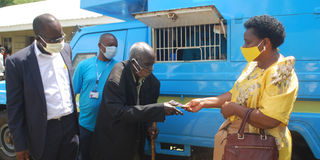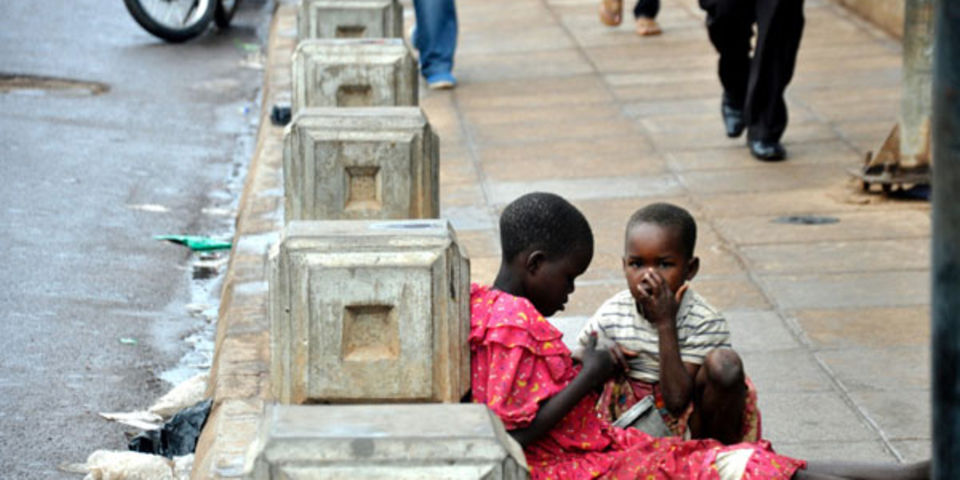Underfunding still hinders social protection programmes

An old man receives cash. Key government programmes meant to benefit persons living with multiple forms of vulnerabilities are not able to effectively cover all target groups with limited funding to social protection. PHOTO/file
What you need to know:
Coupled with other shocks like the recent price hikes, drought in some part of the country, it is highly likely that the gains made in reducing poverty and vulnerability has been eroded.
Investing in disability-inclusive social protection programmes is critical for addressing the diverse risks, poverty, inequalities and exclusion that are often associated with disability.
In safeguarding the situation, in the past years, the government has put in place targeted social protection programmes.
However, a report by the Development Initiative has revealed Social development was among the least funded sectors reflecting the lower priority accorded to social protection.
Underfunding social development has directly contributed to funding gaps that have affected implementation of social protection programmes over the years. Allocations to social development as a share of the national budget continued to decline despite the consistent increase in the national budget.
The report states that the allocation to the social development budget as a share of the national budget declined from 0.7 percent in FY2016/17 to 0.4 percent in FY2020/21.
“The volume of funding allocated to the implementation of social sector programmes has fluctuated in the five-year period between FY2016/17 and FY2020/21. The social protection budget allocated to local governments that implement the devolved functions of the Ministry of Gender, Labour and Social Development has averaged 3 percent of total allocation to social protection.This is quite low compared to the share allocated to the national/central government,” the report states.
Moses Obbo Owori, the senior analyst at Development Initiatives, says, “This means only a very small proportion of those who are supposed to benefit are reached, leaving a vast majority of Ugandan’s population living in poverty and vulnerability unattended to.
With Covid-19, government’s limited funding and coverage under existing social protection programmes is mostly likely further impeded. Shocks in domestic revenue mobilisation capacity can only further constrain government’s capacity to fund social protection.
Under financing
The report states that many social programmes in Uganda are financed poorly, this is often exacerbated by the central government’s failure to disburse approved budget funding to different institutions, creating gaps that affect implementation of social protection programmes.
Shortfall in Social Assistance Grant for Empowerment (SAGE) Budget: Uganda is implementing the SAGE programme aimed at enabling the elderly to access basic services and to start income generating activities for sustenance.
According to the Ministry of Gender, Labour and Social Development, for FY 2022/23, the total budget required to fund the SAGE programme is Shs182.775b but only Shs120.7b is projected to be available, leaving a funding gap of Shs63.75b. This will grossly affect beneficiary verification, registration, enrolment and payments leading to accumulation of beneficiary payment arrears. In addition, the arrears for 270,203 beneficiaries were not paid in FY 2020/21 due to inadequate resources and have not been budgeted for by the MoFPED as committed in FY 2022/23.
“Therefore, government should rationalise the budget allocation within the Ministry and earmark resources to close the funding gap of Shs63.5b, with priority given to paying arrears of SAGE beneficiaries, said Julius Mukunda, the executive director of Civil Society Budget Advocacy Group.
Development Initiative notes most social protection schemes under the social development programme are inadequate and do not reach many of the country’s poorest and most vulnerable people. The approved budget for FY2020/21 did not include any allocation for local government social protection activities.
Trend in budget allocations (approved budget for last five years, FY2016/17 to FY2020/21) the computed figures indicates that in the National budget 2016/17 Shs 194.476 million, Local government 7.640 million, 2017/18 national 177,806 local governmentShs7.640 million, 2018/19, 218,215, local government 7.640 million, 2019/20, 221,349 local government Shs7.640, 2020/21 national budget Shs 187,406 local government was Nil.
Funding allocation to Social Protection for Vulnerable Groups programme take up the largest share of the social development sector budget. This share has fluctuated from 51 percent (in FY2016/17) to 35 percent (in FY2019/20) to 42 percent (in FY2020/21). The fluctuation in funding allocation to social protection programmes seems to be caused by a reduction or zero allocations to some social protection activities in some financial years
Budget share of protection of vulnerable groups,
Allocation of Social protection for vulnerable groups FY2016/17–FY2020/21
FY2016/17: Shs98,632,
2017/18: Shs87,410
2018/19: Shs107,464,
2019/20 Shs77,204,
2020/21 Shs77,862,20.
The key social protection programmes managed by the MGLSD include cash transfers to vulnerable groups, pensions for older people and grants to youth, women and persons with disabilities. The SAGE programme for various vulnerable groups is coordinated and managed centrally by the Expanding Social Protection Programme28 unit under the MGLSD.
Other social protection programmes originally managed by the MGLSD include the Youth Livelihood Programme (YLP) and the Uganda Women Entrepreneurship Programme.
In 2018, the government of Uganda decided that from FY2019/20 the Senior Citizens Grant would be rolled to all 135 districts in the country from the 61 districts hitherto covered.
The Development Initiatives report which has been funded with UK Aid from the UK government, and was developed with the support of the Inclusive Futures consortium. It reveals that presently, Uganda’s districts are covered by the programme with 379,801 beneficiaries (218,205 women and 161,596 men) receiving a monthly cash transfer of Shs25,000.
An assessment of the implementation of this grant by the National Council for Disabilities reveals that the grant has been marred by several challenges including corruption, misuse by beneficiaries, and lack of clear monitoring system, an overreliance on handouts, limited accessibility, and complex requirements for accessing the grant, among others.
Challenges
There are various challenges and gaps within Uganda’s institutional frameworks for social protection.
There is poor coordination between institutions leading to duplication of roles.
“There is also evidence of confusion between the MGLSD and local governments on which one should implement certain activities. There is also evidence of no clear demarcation of social protection roles between central governments ministries, departments and agencies when it comes to implementing social protection programmes,” the report reveals.
Adding: “For example, it is common to find the community mobilisation function scattered across various ministries, departments and agencies, which results in duplication of efforts and a potential waste of resources.”
Solutions
There are only two options for filling the current funding gaps for social protection, First, government can increase funding allocation to the sector from domestic financing using tax revenue.
Mr Owori says government should prioritise increasing allocations to social protection from oil revenues, and other taxes once the economy fully recovers and oil production commences. This is achievable in the medium to long term.
But the second option too is problematic given the possibility of continued decline in donor grants in the medium to long term. Many donor countries are already looking in-wards considering the negative economic impact of the pandemic and now the war in Ukraine.
Under policy, the report stresses that focus legal and policy frameworks for social protection on all groups of vulnerable people including persons with disabilities and children, not just older persons.
Develop social protection policies that are sensitive to the informal sector or amend existing policies to cover it. There should be a policy on assessment and determination of vulnerable populations especially for persons with disabilities.
“This will enable the government to plan for extra costs to be included for any assistance grant such as cash relief, concessions or in-kind support,” the report recommends.
The report reveals that Gaps in implementation of key social protection programmes could indicate monitoring, supervision and coordination gaps between institutions.
In their joint anaylsis, the International Growth Centre (IGC) and the Economic Policy Research Centre (EPRC) said on May 25 during the Ministry of Finance - Bank of Uganda (BoU) Policy Workshop on High Commodity Prices, that providing cash transfers to poor households can be the most efficient way to relieve price pressures. Mobile money provides a cheap delivery method for government.
While presenting the paper, the director of research at Economic Policy Centre (EPRC), Dr Ibrahim Kasirye said the administration of cash transfer programmes must ensure that the poorest households receive the transfers – targeting and administration.
“Poor households have suffered the largest reduction in consumption, and have the least capacity to absorb price increases. Focus on reforms that are already on government’s agenda, refrain from introducing distortions,” said IGC/EPRC.



